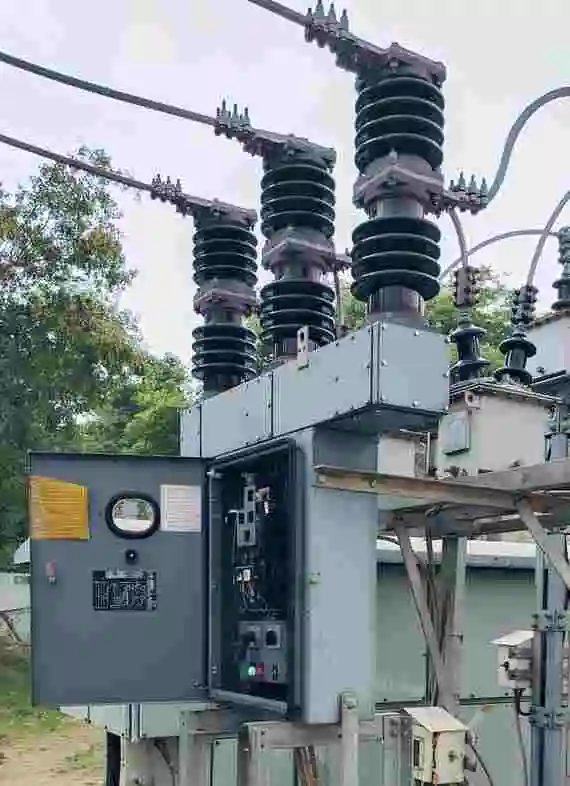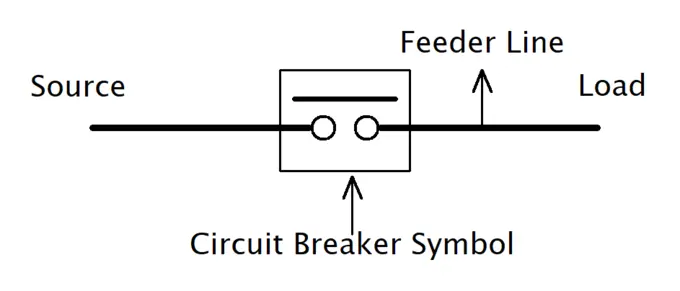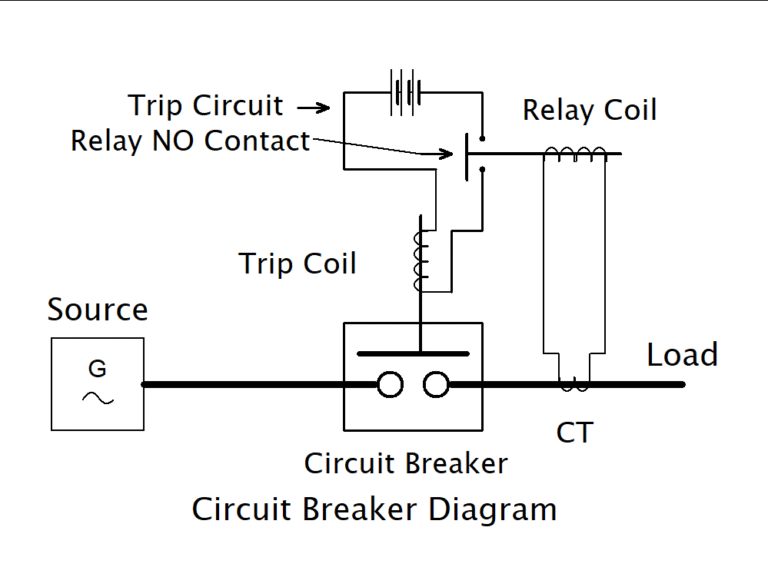Types of Circuit Breakers - Functions, and Applications
Table of Contents
ToggleWhat is a circuit breaker? What is the function of a circuit breaker? How many types of circuit breaker are there? What are the applications of circuit breakers? Advantages and disadvantages of circuit breaker. Whenever we think about circuit breakers, all these questions keep roaming in our minds. Through this article, we will know the answers to all these questions.
What is Circuit Breaker?

A circuit breaker operates automatically to stop damage to electrical circuits from overcurrent, short circuits or overloads. It is mainly used to interrupt the flow of current after a fault is detected. Rather than discarding a broken fuse, a person can press a button or manually pull a circuit breaker to turn it back on after it turns off.
Circuit breakers are important for the safety and smooth running of electric systems. Some fuses shield home appliances and other smaller ones, as well as giant switchgear meant to look after powerful circuits in the grid.
What is the function of Circuit Breaker?
Here are the most important roles that a circuit breaker plays:
- Some of the key purposes of a circuit breaker include circuit protection, quick response during electrical failures and circuit reconnection.
- IFC happens automatically in cases of a fault current.
- When abnormal power (overload or short circuit) is detected, the device immediately cuts the circuit to stop the power.
- Saves Electrical Equipment From Damage. Avoids possible overheating, fire and damage to appliances and machinery by checking for continuous electricity.
- Ensures Humans Are Protected from Risk. Safeguards people from potential shocks, burns and fires resulting from any flaws in the electrical system.
- It switches Signals Between Tracks. You can switch it on and off manually, or the switch can be set to do this automatically as if it were a control switch.
- It separates the bad part of the power system from the rest, so other areas can keep working as usual.
- A reset is all that’s needed once the fault is addressed, as replacing it with a fuse isn’t required.
- Designed to have thermal, magnetic or electronic sensors to keep up with running current and act swiftly if there is a problem.
- It works well for housing, shopping areas, factories and network settings.
How Circuit Breaker Works?
A circuit breaker works in several ways: it detects a fault, shuts off the circuit, puts out any arcs and brings the circuit back to normal. In the following, you will find a detailed outline of the process in bullet points:
Normal Operation
- As it stays closed, the current is allowed to continue its regular flow.
- It doesn’t stop the electricity but follows the level of current all the time.
- If the current does not exceed the safe operating range, the breaker stays still, and the circuit is functional.
Fault Detection Mechanism
Circuit breakers are intended to locate two important types of faults.
Overloads condition:
- Overload Condition limits the amount of energy an engine can transfer.
- The system experiences an overload when it gets more current than it can handle for a certain amount of time.
- A thermal trip unit that uses a bimetallic strip detects the trapped current.
- The heat produced by charging too much current causes the strip to bend.
- Once the conductor bends enough, the mechanism next to it activates, and the contacts are opened.
2. Short Circuit Condition
- A surge in the amount of current is caused by connecting live and neutral or ground directly.
- The presence of the magnetic trip unit or solenoid lets the system know.
- The buildup in pressure gives off a strong magnetic field, which pulls a lever and allows the trip to fire.
3. Advanced Electronic Detection:
- Modern circuit breakers have microprocessors and current transformers (CTs) to quickly and exactly detect faulty conditions.
- They have programmable functions and are quick to respond to several different mistakes.
Tripping Mechanism
- Once the fault is discovered, the trip mechanism is put into use.
- Because of this, the breaker’s contacts are forced apart, and the circuit is interrupted.
- The different parts of the circuit are instantly broken to stop any sparks and prevent the fire.
Types of Tripping Mechanisms:
Thermal Tripping: relates to use in thermal circuit breakers.
- The overcurrent causes the bimetallic strip to bend, which starts the trip.
Magnetic Tripping: used in magnetic circuit breakers.
- Due to the strong magnetic field, the solenoid pulls the plunger or lever into motion since this trip is the breaker.
Electronic Tripping:
- Uses sensors to detect when the current flow is too much or has become a short circuit, and the microprocessor trips the breaker.
Arc Formation and Extinction:
- An electric arc takes place between the contacts when they are pulled apart by a magnet.
- The arc must be put out to stop the current from flowing.
- Some circuit breakers stop arcs by cooling them, and others by isolating them.
- It utilizes compressed air pressure to blow the arc away.
- The arc is extinguished in a specialized vacuum for the Vacuum Circuit Breaker.
- An Arc is put out in the insulating oil inside the oil circuit breaker.
- Sulfur hexafluoride gas is used in SF₆ circuit breakers to cut off arcs.
Resetting and Restoration
- In the Restart process, the key is Resetting and Restoration.
- After the fault is fixed, residential breakers should be manually reset, and advanced systems will perform the resetting automatically.
- Unlike a fuse that needs replacement after being used, a circuit breaker is reusable and can be turned on again quickly.
Types of Circuit Breaker
There are many types of circuit breakers, based on their application and on what material they use to put out arcs.
Based on System Current:
There are two types of circuit breakers depending on the system current:
- AC Circuit Breaker
- DC Circuit Breaker
AC Circuit Breaker
They are designed to break the alternating current. In AC supply, the current changes direction with time, so these breakers are designed in such a way that they can safely interrupt this changing current.
AC circuit breaker is used in domestic and industrial electrical systems. There are many types of AC breakers. Some common types of circuit breakers are:
- Miniature Circuit Breaker (MCB)
- Molded Case Circuit Breaker (MCCB)
- Air Circuit Breaker (ACB)
- Oil Circuit Breaker (OCB)
- Vacuum Circuit Breaker (VCB)
- Sulfur Hexafluoride (SF6) Circuit Breaker
- Residual Current Circuit Breaker (RCCB)
- Differential Current Circuit Breaker (RCD)
DC Circuit Breaker
These are designed to break direct current. Interrupting DC current is a little more challenging than AC because, in DC, the current flows in a constant direction and an arc (sparking) can easily occur. Hence, DC circuit breakers require more powerful and specialized components to handle this specific condition.
DC circuit breakers are used in renewable energy systems (such as solar panels) or electric vehicles (EVs).
There are also some specific types of DC circuit breakers. Some common types of circuit breakers are:
- Air Circuit Breaker (ACB) for DC
- Oil Circuit Breaker (OCB) for DC
- Vacuum Circuit Breaker (VCB) for DC
- Solid-State Circuit Breaker (SSCB)
- Magnetic DC Circuit Breaker
- Hybrid DC Circuit Breaker
- DC Residual Current Circuit Breaker (RCCB)
- Thermal Circuit Breaker
Based on Arc Extinguishing Medium:
Air Circuit Breaker(ACB)
The air is the main medium used for quenching the arc. Usually applied for low-voltage applications that are not more than 690V.
Oil Circuit Breaker (OCB)
In oil circuit breaker the arc is extinguished by insulating oil It can be applied in high-voltage systems.
Vacuum Circuit Breaker (VCB)
In a vacuum circuit breaker, a vacuum is used for quenching the arc. The insulators are ideal for use in medium-voltage systems, up to 38 kV.
SF₆ Circuit Breaker.
Sulfur hexafluoride gas is used to put out the arc. This types of circuit breaker is built for electricity transmission at greater than 72.5 kilovolts.
Based on Operating Mechanism:
- Manual Circuit Breaker
- Automatic Circuit Breaker
- Remote-Controlled Circuit Breaker
Installation Location:
- Indoor Circuit Breaker
- Outdoor Circuit Breaker
Based on Voltage Level:
- Low Voltage (up to 1 kV)
- Medium Voltage (1 kV to 72.5 kV)
- High Voltage (above 72.5 kV)
Circuit Breaker Symbol
A circuit breaker is usually represented in an electrical diagram by a switch graphic. Generally, people depict it as follows:

A switch shows a disruption in the electrical circuit that people can manipulate. In some cases, you may add a box with the letters “CB” inside to highlight that the breaker is for the power system in diagrams.
Circuit Breaker diagram
It uses pictures to illustrate the structure and operations of a circuit breaker. It explains the way the breaker notices faults and blocks current from going through.

Circuit Breaker Parts
Well, there are different types of circuit breakers. If we start describing all types of breaker parts, it will not be possible in one article. Still, here we will discuss the main types of breaker parts which are used in almost all types of breakers.
Fixed Contact: It remains in one location and links to what you want to lift.
Moving Contact: Opens or stops current from flowing; it is connected to the operating mechanism.
Arc Chute: Part of the circuit where the arc is broken off once contacts open.
Trip Coil or Relay: One possible choice is the Trip Coil or Relay. If a surge of current is detected, the mechanism is set off.
Operating Mechanism: Ops the contacts between the plates, depending on the type of controller (there are two ways to do this: by hand or automatically).
Insulation: Tracks and controls any leaking current to ensure no accidents happen.
Breaking Capacity of Circuit Breaker
A circuit breaker’s breaking capacity refers to the most current it can stop without getting damaged. The damage or interrupting capacity is important for selecting the most suitable circuit breaker for any setup and is frequently referred to as rupturing capacity.
The amount of breaking capacity is most often given as kiloamperes (kA) RMS at the system voltage. It describes the maximum amount of current the breaker addresses while everything is working as usual. Thus, a breaker with a 25 kA rating can interrupt up to 25,000 amperes without any error.
There are two kinds of breaking capacities
Rated Symmetrical Breaking Capacity (Ics): based on symmetrical fault current without any DC component.
Ultimate Breaking Capacity (Icu): Even if the breaker is interrupted while carrying the maximum current it can support, it may still work but will likely have to be changed afterwards.
The maximum possible short-circuit current should never be higher than the breaking capacity of the circuit breaker for safety reasons. If the capacity to break power is not high enough, the breaker cannot interrupt the fault, and this could cause damage, fire or threats.
Applications of Circuit Breaker
Residential Applications
- Appliances and wires in your home are protected from too much current and short circuits by having circuit breakers.
- When wiring domestic circuits such as lighting or fans, MCBs are the common electrics put in use.
- RCCBs are designed to stop electric currents from shocking people by finding leakage.
Commercial Applications
- This type of breaker is used in offices, malls, medical facilities and schools for the safety and organization of wiring.
- HVAC systems, elevators, lighting and high-load machines rely on the use of Molded Case Circuit Breakers (MCCBs).
Power Generation and Its Delivery
- Power plants rely heavily on circuit breakers for their operations.
- They act as a shield against flaws that might damage generators, transformers and lines.
- Circuit breakers filled with SF₆ gas and oil can be seen in most high-voltage power transmission networks.
Industrial Applications
- Make sure heavy-duty equipment and powerful motors are safely kept in all production areas and factories.
- Those systems require vacuum and SF₆ circuit breakers to ensure safe and reliable performance.
- Applications include motor control centres, distribution panels and process control automated systems.
Transportation and infrastructure
- For the electricity needs of railway systems, airports and metros, single phase types of circuit breakers are employed for the traction system and signalling equipment.
- Secure underground tunnels, data centres and public utility infrastructures from faults.
Advantages and Disadvantages of Circuit Breaker
Advantage
- Automatic Operation: Circuit breakers find issues by themselves and cut off the electricity supply automatically, keeping things safe.
- Quick Response: Should an overcurrent or short circuit happen, they respond right away by protecting the equipment.
- Reusability: Unlike fuses, you can reset circuit breakers after they trip, and they do not have to be replaced every time.
- High Reliability: Electrical circuits in homes and factories are well protected by the reliability of circuit breakers.
- Wide Application: Thanks to their flexibility, they may be used in homes, factories and for generating electricity in plants.
- Maintenance-Friendly: Circuit breakers found now often do not need much attention and can keep working for years.
- Safe choices for the environment can be found: Things like vacuum and SF₆ circuit breakers are built to reduce challenges to the environment.
Disadvantage
There are some challenges related to using Circuit Breaker.
- Higher Cost: Circuit breakers are costlier than normal fuses when it comes to high-voltage situations.
- Complex Mechanism: The process of building and running these power plants is detailed, so it takes skilled people to assemble and look after them.
- Failure Possibility: If maintained incorrectly, circuit breakers might not protect the equipment and provide safety, resulting in problems or harm.
- Environmental Concerns: Some circuit breakers use SF₆, a dangerous greenhouse gas, and it should be treated with great care.
- Size and space: Because high voltage circuit breakers can be dangerous, they need more room and attention when housing them.
Conclusion
Nowadays, effective electrical systems rely on circuit breakers to prevent overcurrents and mitigate various electrical issues. They help prevent fires, protect equipment, and safeguard lives, as they automatically respond to any disturbance in electrical flow.
The safety, dependability and running efficiency of the electrical systems depend on selecting and maintaining the right circuit breakers. Having a good knowledge of motors, their operation, types and uses is necessary for electrical engineers, builders and maintenance personnel. From a circuit breaker used in a home to one in a power plant, this gadget is essential and makes a big difference.
I am an engineer in a government department and also a blogger. I write posts on topics related to electrical and electronics engineering.
